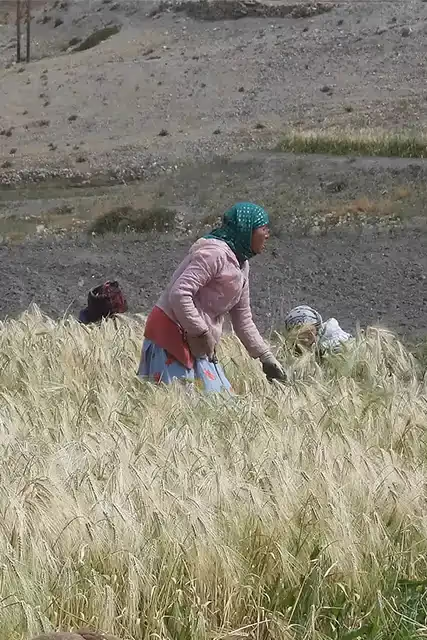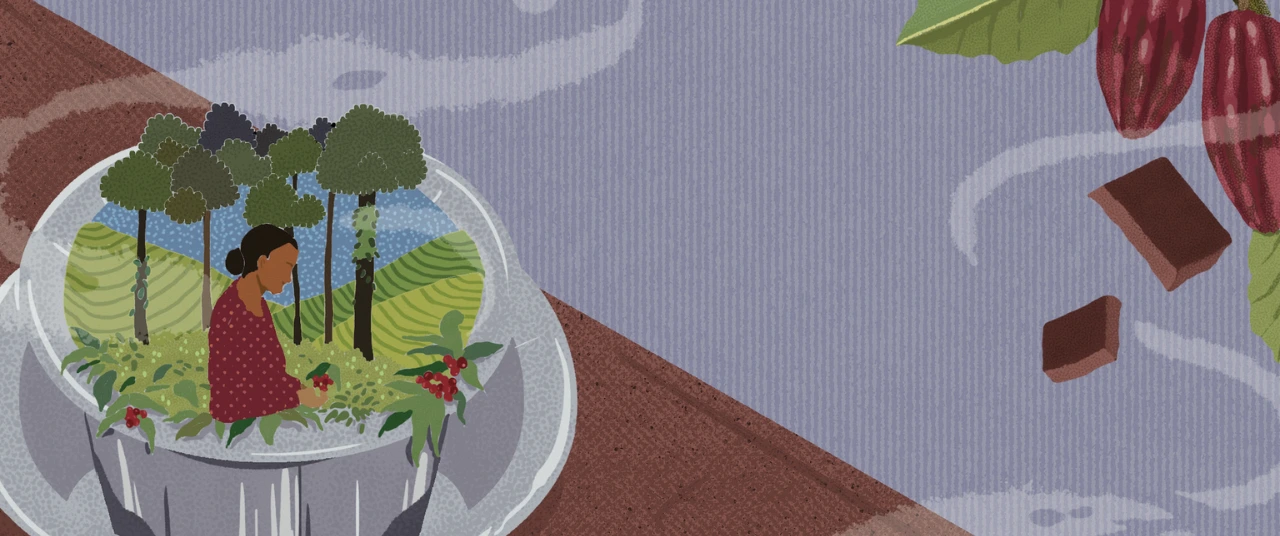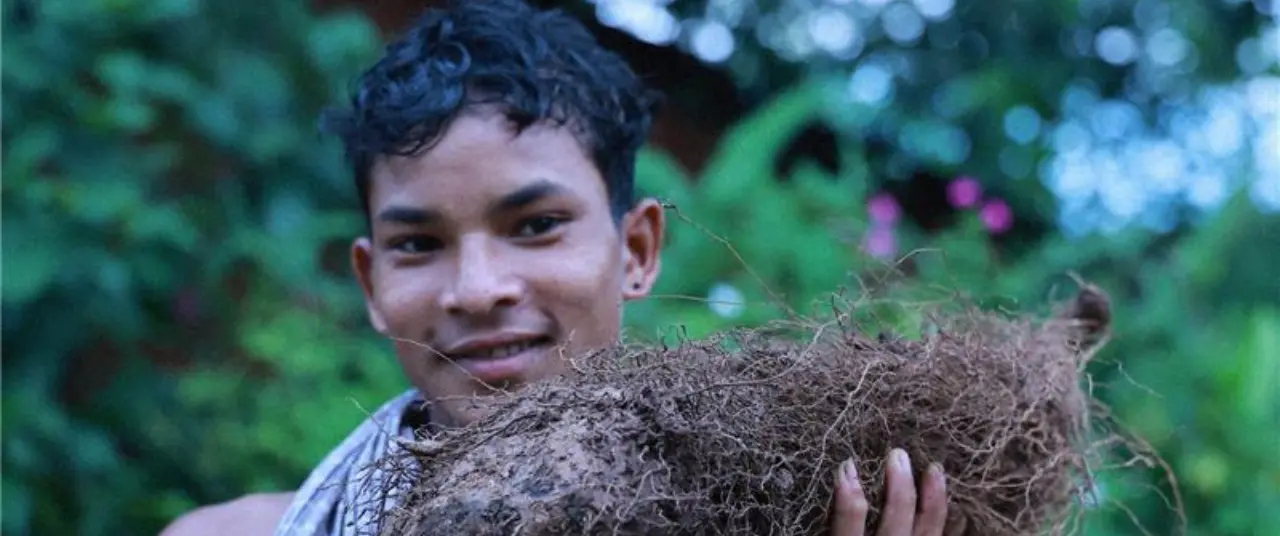Farmers are switching to cash crops like peas






Barley holds deep cultural significance in the high altitudes of Himachal Pradesh, particularly in Spiti. This ancient crop is linked to the Namkhan festival, and it is harvested only after the festival, showing how much it matters.
In the past, three types of barley, locally known as jau, were cultivated in Spiti. “The crop was consumed and also exchanged for other essential items. Now, only one variety is grown, mostly eaten as sattu after roasting. It is naturally grown during the summer,” said Tenzin Thinley, a farmer from Kibber village.
According to Thinley, people in Spiti still trade barley for rice from Kullu and Manali. They also buy aluminium storage boxes, or sanduk, for preserving it, underscoring its importance.

Fading barley
However, barley cultivation has declined since the introduction of green peas as a cash crop in the 1980s. "Today, only about two to three quintals of barley get sold, fetching around Rs 42 per kilogram locally," said Thinley. Peas have brought higher profits, pushing barley aside.
Though peas are commercially viable and planted around the same time as barley, they come with drawbacks. "Climate change is the biggest threat. Pea crops are often ruined by excessive rain and hail in June and July when they're nearly ready for harvest. Barley, on the other hand, can endure such climate shocks. But most farmers now grow peas for financial reasons," Thinley said.
Thinley believes small-scale farmers who only grow peas are more vulnerable to unexpected climate changes. Additionally, as barley farming declines, the younger generation may gradually forget its importance in Spiti.

Crop switch
Barley is mainly grown for consumption, but its market value is almost zero. In Spiti, many farmers saw their fortunes improve about four decades ago when they started growing peas. According to Thinley, barley barely sells despite his efforts to find a market. He owns 49 bighas of land, where he practises crop rotation. If he cultivates about 10 bighas one year, he leaves that much land fallow the next year due to water shortages.
“Last year, peas sold for Rs 95 per kg, but this year it was Rs 75 per kg. If farmers find a viable market for barley, many will reduce pea cultivation since it requires more water.”
Peas and barley are sown together around March-April. The crops are harvested in mid-September to October, although this year the harvest came early, leading to lower prices for peas.
Climate change is the biggest threat. Pea crops are often ruined by excessive rain and hail in June and July when they're nearly ready for harvest. Barley, on the other hand, can endure such climate shocks.
Over the past few years, Thinley has noticed that the harvest has moved up to August. “Overall, this is due to a changing climatic trend in Spiti”
The early harvest is a major issue. Farmers miss out on the higher prices available in September and October. Since the crop is ready in August in lower elevations, overproduction drives prices down, Thinley said.
Pea farming typically brings in a profit of Rs three to four lakh annually for many, with most of the produce sent to Delhi. Thinley is worried that, at some point, farmers might suffer big losses from growing peas, and barley could completely disappear from the area.
Impact of tourism
In Spiti, where people rely on livestock and pea farming for their livelihoods, tourism has also brought changes. Thinley said many tourists now visit Spiti in winter to see snow leopards. “In winter, it’s like a fair here, full of outsiders. Even Western-style toilets have been installed for tourists, but they don’t work in the cold.” If pea crops fail in any given year, horses and yaks are sold for income.
Another farmer from Kibber village, Dorje Chhering, grows both peas and barley. He began cultivating peas in 1988. Chhering owns 30 bighas of land, planting peas on 10 bighas and barley on another 10. The rest remains fallow.

According to Chhering, pea crops require more water, a resource always scarce in the region. Farmers build kuls, or water channels, to bring glacial water to their fields. He sources water from eight km away. Plus, Kuls, traditional water harvesting systems in Spiti, need proper management and maintenance.
“There is a severe water shortage here. I’m not getting a good market for barley, but I’ve heard there’s demand. If I find a viable market, I’ll stop growing peas. Peas are always risky. The seeds aren't local, which is the biggest problem. In summer, when peas are sown, water can be scarce. When they’re ready, excess rain or hail storms can ruin the crop,” Chhering said. He added that barley is a hardy crop, resistant to climatic shocks, and beer made from barley tastes good.
There is a severe water shortage here. I’m not getting a good market for barley, but I’ve heard there’s demand. If I find a viable market, I’ll stop growing peas.
Takpa Tenzin, a resident of Chicham, a village five km from Kibber, said, “Farmers in Spiti buy pea seeds at subsidised rates, but most of the time they’re poor quality. Middlemen often cheat us by providing inferior seeds. Last year, I bought four kg of pea seeds for Rs 4,200. Still, one kg of peas sells for Rs 60-70 in the market.”
Like others in the region, he’s aware of the risks posed by peas. Farmers lack storage facilities, and with markets far away, they rely on middlemen to sell their crops. These middlemen come from various districts in Himachal Pradesh after the harvest.

Alternative income
Besides the commercially viable green pea, Takpa Tenzin also grows black peas, or kala matar in Hindi. This local Spiti variety lacks a market as well. Though it looks green in the field, the peas are slightly blackish. When snow, rain, or road blockages occur, farmers struggle to store green peas for long periods. But black peas, dried in the fields, can be stored for up to a year. They’re small and must be beaten with sticks to remove the pods.
“I’m trying to find a market for black peas. Once, I sent about two quintals to Gujarat through a friend,” he said. But there’s been no promotion for the crop. Thinley added that black peas are exchanged for rajma from Kinnaur, where people appreciate their nutritional value and taste.
Though Spiti is part of the trans-Himalayan region, water shortages are still constant. “The pea crop needs water 10-12 times from sowing to harvest. In high mountains, farmers rely on springs. But the constant pressure from tourism also affects the region’s water sources. Farmers use PVC pipes to bring water to their fields, but the springs, their water source, are gradually drying up.”
Takpa Tenzin, who also runs a homestay, said things have changed. Most people in Spiti now run homestays. Namkeen chai, once popular in the region, has been replaced by regular sweet tea.
Meanwhile, farmers in Kibber gram panchayat have vowed to avoid using chemicals. “Chemical use reduces the bird count. If farmers stop using chemicals, birds return in large numbers.”
{{marquee}}
Hardy crop
Ajay Bijoor, who works with the Nature Conservation Foundation’s high-altitude programme, said the green pea crop was introduced to Spiti from Lahaul. Lahaul farmers have grown cash crops, including potatoes, since the 1960s.
“Barley needs less water than green peas, but cash crops like cauliflower and lettuce require even more. The first watering of crops is now delayed due to reduced snowfall and receding glaciers, which disrupts the crop cycle.”
Barley is one of the oldest crops known to humans. Bijoor explained that Spiti was likely inhabited because barley was cultivated here since ancient times. This long history has given the crop its resilience to climate change.
{{quiz}}
Explore other topics
References

Farmers from which place introduced Spiti to the green pea crop?


























.png)



